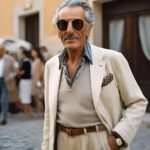In the fast-paced world of medicine, where long hours and rigorous demands are part of daily life, maintaining a sense of style can seem like an afterthought. However, fashion for doctors is more than just looking good; it is about striking the right balance between professionalism, comfort, and personal expression. This guide explores how doctors can integrate style into their work wardrobes without compromising functionality or their professional image.
Why Fashion Matters for Doctors
1. The Role of First Impressions
First impressions matter in any profession, and for doctors, they are no exception. Patients often associate a doctor’s appearance with their competence, reliability, and attention to detail. A polished and professional look helps establish trust and conveys a sense of authority.
2. Boosting Confidence and Morale
Fashion can also have a significant impact on personal confidence. When doctors feel good about how they look, it can positively affect their interactions with colleagues and patients, boosting morale even during challenging shifts.
3. Reflecting Personal Style Within Professional Boundaries
While adhering to dress codes, doctors can still showcase their personality. Thoughtfully chosen attire allows them to feel more comfortable and authentic while maintaining the decorum required in healthcare settings.
Essential Fashion Tips for Doctors
1. Prioritize Comfort
Long hours and unpredictable schedules demand clothing that is both comfortable and durable. Choose breathable fabrics, such as cotton or moisture-wicking blends, to stay fresh during busy days.
- Practical Shoes: Comfortable footwear is crucial. Invest in supportive shoes, such as clogs or sneakers designed for healthcare professionals, to prevent foot fatigue during long shifts.
- Fit Over Trends: Opt for well-fitted clothing that allows ease of movement. Tailored scrubs or professional attire that accommodates physical activity is ideal.
2. Embrace Versatility
Doctors often juggle various roles, from consulting patients to attending meetings. Versatile pieces that transition smoothly between professional and casual settings are invaluable.
- Layering Options: Layering not only adds style but also prepares you for varying temperatures in hospitals or clinics. Lightweight cardigans, blazers, or vests can add a polished touch to your outfit.
- Neutral Colors: Neutral colors like navy, gray, or beige work well in healthcare environments, as they convey professionalism and are easy to mix and match.
3. Invest in High-Quality Scrubs
Scrubs are a staple for many doctors. High-quality scrubs that are stain-resistant, durable, and tailored can make a significant difference.
Features to Look For:
- Pockets for carrying essentials.
- Stretchable fabric for unrestricted movement.
- Wrinkle-free materials for a neat appearance.
4. Accessorize Thoughtfully
Accessories can elevate a simple outfit but should remain functional and understated in healthcare settings.
- Watches: A durable, water-resistant watch with a second hand is not only stylish but also essential for monitoring vital signs.
- Minimal Jewelry: Keep jewelry minimal and secure. Small stud earrings or a simple chain can add elegance without posing safety risks.
- Practical Bags: Choose a structured tote or backpack with multiple compartments to carry essentials like medical tools, notepads, and personal items.
Fashion for Different Settings
1. Hospital Settings
In hospital environments, functionality often takes precedence over style. However, this doesn’t mean sacrificing a polished look.
- Scrubs with a Twist: Opt for scrubs in flattering cuts and subtle colors. Brands that cater to healthcare professionals often offer stylish options without compromising on practicality.
- Comfortable Layers: Hospitals can vary in temperature, so layering with a well-fitted jacket or cardigan adds both style and comfort.
- Private Clinics: In private clinics, the dress code might lean towards business casual. This allows more flexibility in showcasing personal style while maintaining professionalism.
- Blouses and Shirts: Choose tailored blouses or button-up shirts in neutral or soft colors. These pair well with slacks or skirts for a polished look.
- Footwear: Stylish loafers, flats, or low-heeled shoes strike the right balance between comfort and formality.
2. Academic or Administrative Roles
Doctors involved in teaching or administrative duties can opt for business professional attire. This includes suits, blazers, or dresses that exude authority.
- Statement Pieces: A well-tailored blazer or an elegant scarf can add personality without overshadowing professionalism.
- Seasonal Adaptations: Adapt your wardrobe to the seasons with lightweight fabrics in summer and cozy textures in winter, ensuring comfort throughout the year.
Gender-Specific Fashion Tips
1. Fashion for Female Doctors
- Dresses and Skirts: Choose knee-length dresses or skirts with modest cuts. Pair them with tights for added comfort and professionalism.
- Makeup and Grooming: Keep makeup minimal and opt for hairstyles that are practical yet stylish, such as a neat bun or ponytail.
2. Fashion for Male Doctors
- Tailored Shirts: Opt for wrinkle-free, tailored shirts in classic colors like white, blue, or gray.
- Ties: If ties are part of the dress code, choose patterns that are subtle and professional.
Overcoming Common Challenges
1. Dealing with Stains
Healthcare environments are prone to spills and stains. Invest in stain-resistant fabrics and carry a stain remover pen for emergencies.
2. Managing Long Hours
Opt for clothing that maintains its shape and comfort even after long hours. Anti-wrinkle and moisture-wicking materials are excellent choices.
3. Staying Stylish on a Budget
Being stylish doesn’t require an extensive budget. Focus on quality over quantity and invest in versatile pieces that can be styled differently.
Top Brands for Doctors
1. Scrubs and Medical Wear
- Figs: Known for their stylish and comfortable scrubs.
- Grey’s Anatomy: Offers high-quality, professional-looking medical wear.
- Cherokee: Budget-friendly options with a variety of styles.
2. Professional Attire
- Brooks Brothers: Ideal for business casual and professional wear.
- J.Crew: Offers versatile pieces suitable for different settings.
- Clarks: Known for their comfortable and stylish footwear.
FAQs
How to be stylish as a doctor?
To be stylish as a doctor, focus on balancing comfort and professionalism. Choose well-fitted, high-quality scrubs, neutral colors, and breathable fabrics. Add subtle accessories like a functional watch and minimal jewelry, and layer with blazers or cardigans for added style.
What kind of clothes does the doctor wear?
Doctors typically wear scrubs, which are comfortable and functional for long shifts. In certain settings, such as private clinics or administrative roles, doctors may opt for business casual attire like tailored shirts, blouses, slacks, and skirts.
What should I wear to the doctor?
When visiting the doctor, wear comfortable, easy-to-remove clothing. A simple outfit like a loose top, pants, or a dress works well, especially if you’ll need to change into a gown for an examination.
What are doctor clothes called?
Doctor clothes are commonly called scrubs. Scrubs are designed for comfort and practicality, typically consisting of a top and pants made from breathable, easy-to-clean fabric.
What is doctor dress?
A doctor dress refers to the professional attire worn by medical professionals. In hospitals, this usually includes scrubs, while in more formal settings like clinics, it may also involve business casual wear, including tailored shirts, blouses, and slacks.
What do doctors use most?
Doctors most commonly use tools like stethoscopes, medical charts, and computers. They also rely on practical items like watches for monitoring time and essential medical tools stored in pockets of their scrubs.
Conclusion
Fashion for doctors is about finding the perfect harmony between style, comfort, and professionalism. By investing in high-quality, versatile clothing and accessories, doctors can project a confident and polished image while meeting the demands of their rigorous schedules. With the right approach, fashion becomes a tool that enhances not only appearance but also morale and patient trust, making it an integral part of a doctor’s professional identity.



